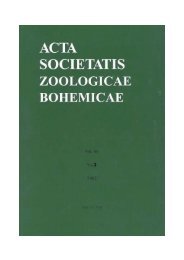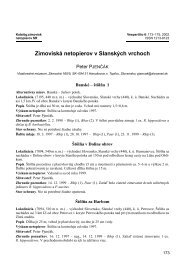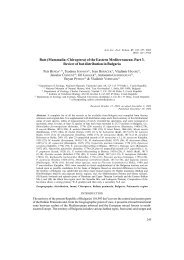Fluid inclusion and stable isotope study of the Kasejovice gold district, central Bohemia+6‰ SMOW at 360 to 300 °C) of which do not allow distinguishingbetween deep crustal metamorphic or magmaticfluids. Salinities and homogenization temperatures(Th-tot) of primary (P) inclusions are slightly higher thanthose of pseudosecondary (PS) ones (Fig. 6). Both P andPS inclusions have highly variable H 2 O/CO 2 ratios (Fig. 5)and homogenize both to vapour and liquid states (few inclusionsdisplayed also the critical behaviour). This maybe indicative for a trapping from a heterogeneous fluid.Unambiguous interpretation, however, is not possible. Ifheterogeneous trapping occurred, the lowest Th-tot(250–220 °C) could be interpreted as trapping temperatures;otherwise (i.e. for homogeneous trapping) the trappingtemperatures could be 300–350 °C or higher.Temperatures estimated by oxygen isotope thermometry(quartz-wolframite mineral pair) correspond to 360 °C.In contrast to the primary and pseudosecondary inclusions,the salinities of secondary (S) inclusions vary significantly(Fig. 6). The T FM data indicate unambiguouslyat least two distinct salt systems (H 2 O-NaCl-CaCl 2 andH 2 O-MgCl 2 ). In addition, the presence of FeCl 2 cannot beexcluded. Both salt systems evolve from a higher salinity– higher temperature fluids towards low salinity – lowertemperature fluids during the evolution of individual typesof secondary fluid inclusions (Fig. 6; trends A and B forH 2 O-NaCl-CaCl 2 and H 2 O-MgCl 2 fluids, respectively).Such a large decrease in salinity, accompanied by minorchanges in Th-tot, can be explained by a mixing with alow-salinity, 120–100 °C hot fluid only. A concomitant decreasein temperature and salinity (trend C, dotted arrows,Fig. 6), indicated by one-phase liquid fluid inclusions,could be induced by rapid fluid cooling due to a large temperaturedifference between the fluid and the host quartz.Sector zoning of the oldest quartz grains (within onevein structure) indicates rapid growth and disequilibriumpartitioning on crystallographically non-equivalent faces(Reeder 1991, Kerestedjian 1997). Euhedral habitus ofsuch grains testifies for open-space filling. Subsequentsudden increase in the grain-size and general absence ofremarkable CL-zoning in such grains testify for a changein kinetics of quartz precipitation and probably also influid dynamics during the precipitation of vein core zones.Isochores for representative fluids trapped in primaryand in secondary inclusions are shown in Fig. 7. Conditionsof supposed quartz-1 deposition are marked by ashadowed polygon. This region corresponds to trapping ofH 2 O-rich and CO 2 -rich end-members of the unmixedH 2 O-CO 2 -CH 4 -salt fluid. Based on comparison with experimentalH 2 O-CO 2 -NaCl solvus (dashed-dotted lines labelled5, 10, 30 for fluids containing 5, 10, 30 mol% CO 2and 2 wt% NaCl; interpolated from data of Bowers andHelgeson 1983) it can be deduced that the CO 2 content inthe original homogeneous fluid (i.e. before unmixing)varied approximately between 25 and 7 mol%. The absenceof primary inclusions trapped unambiguously froma homogeneous fluid can be explained by extensionalPressure (bars)300025002000150010005000Isochores:CO 2 -richH 2 O-richH 2 O-onlyEarly secondaryLate secondary0 50 100 150 200 250 300 350 400 450Temperature (°C)Fig. 7. Fluid inclusion isochores for representative fluid types. Thickdouble arrowed line represents a hypothetical P-T path of mineralizingstages. The shadowed polygon corresponds to the most probable field oftrapping of unmixed aqueous-carbonic fluids representative of the quartzstage, the ellipses correspond to younger mineralization stages (goldbearing?, base-metal and calcite). The dashed-dotted lines correspond toH 2O-CO 2 solvi for 5, 10 and 30 mol% CO 2 and 2 wt% NaCl (interpolatedfrom the data of Bowers and Helgeson 1983).character of quartz veins, the formation of which wasaccompanied by a sudden decrease in fluid pressure andsubsequent fluid heterogenization.In contrast to the quartz stage, exact P-T-X conditionsof the gold-bearing stage are difficult to assess. It is clearthat the fluid responsible for precipitation of gold must beone (or more) of those trapped in pseudosecondary or secondaryinclusions. It should therefore correspond to isochoresfor either late aqueous-carbonic inclusions (PS orS0) or early secondary aqueous-only ones (S1-S3). Thepresence of H 2 S in the gaseous phase of P inclusionsallows to suggest that the Au(HS) 2—complex can be held responsiblefor gold transport. The mineralogical variety ofgold-bearing and base-metal mineralization stages couldbe related to the complexity of salt systems of aqueousfluids.The evolution (P-T path and fluid composition) of theKasejovice mineralization is generally similar to otherVariscan gold deposits in the Central Bohemian MetallogenicZone (Zachariáš et al. 1997, Morávek et al. 1992,Boiron et al. 2001). In details, however, it differs in slightlylower temperatures of the first (i.e. quartz) mineralizationstage and in much larger compositional variety ofaqueous fluids during the late hydrothermal stages. TheP-T-X fluid evolution of the Kasejovice district is similaralso to the characteristics of the general model of EuropeanVariscan gold mineralizations (Cathelineau et al.2000, Noronha et al. 2000).10530primarypseudosecondary163
Jiří Zachariáš – Marta PudilováConclusionsThe early mineralization stages of the Kasejovice districtevolved from a complex H 2 O-CO 2 -CH 4 -N 2 -H 2 S-CaCl 2 -NaCl (XCO 2 : 0.25–0.07), low salinity (3.0–1.5 wt%NaCl eq.) fluid. The precipitation of quartz gangue occurredmost probably at 2–1 kbar and 220–300 °C from unmixedaqueous-carbonic fluid. The late mineralizationstages occurred from aqueous fluids at temperatures from~200 to ~100 °C and pressures of about < 0.5 kbar. Isotopecomposition of early fluids (i.e. quartz stage; δ 18 O fluid :+8 to +6‰ δ 18 O SMOW at 360–300 °C) does not allowdiscriminating between deep-crustal metamorphic andmagmatic fluids. With respect to the suggested temperaturesof quartz precipitation and fluid composition (i.e.CO 2 -CH 4 -H 2 O ratio), a metamorphic source is, however,more likely.Acknowledgements. This research was supported by the GrantAgency of Charles University, project No. 221/1999/B-GEO/PrF, and bythe grant of the Ministry of Education to the Faculty of Science, CharlesUniversity (CEZ: J13/98:113100005). The micro-Raman spectrometry(DILOR) analyses of fluid inclusions were performed by M. C. Boiron atthe CREGU, Nancy, France.ReferencesBakker R. J. (1999): Adaptation of the Bowers and Helgeson (1983)equation of state to the H 2O-CO 2-CH 4-N 2-NaCl system. Chem. Geol.,154, 225–236.Bodnar R. J. (1993): Revised equation and table for determining thefreezing point depression of H 2O-NaCl solutions. Geochim. Cosmochim.Acta, 57, 683–684.Boiron M. C., Barakat A., Cathelineau M., Banks D. A., Ďurišová J.,Morávek P. (2001): Geometry and P-V-T-X conditions of microfissuralore fluid migration: the Mokrsko gold deposit (Bohemia).Chem. Geol., 173, 207–225.Borisenko A. S. (1977): Izuchenie solevogo sostava rastvorov gazovozhidkikhvklyucheniy v mineralakh metodom kriometrii. Geol. iGeofiz., 8, 16–27. NovosibirskBowers T. S., Helgeson H. C. (1983): Calculation of the thermodynamicand geochemical consequences of nonideal mixing in the systemH 2O-CO 2-NaCl on phase relations in geologic systems: Equation ofstate for H 2O-CO 2-NaCl fluids at high pressures and temperatures.Geochim. Cosmochim. Acta, 47, 1247–1275.Cathelineau M., Boiron M. C., Banks D., Vallance J., Fourcade S., MarignacCh. (2000): Fluid mixing and gold deposition during uplift ofthe Hercynian belt. In: Metallogeny 2000, Review and perspectives,33–34. Nancy.Clayton R. N., Mayeda T. K. (1963): The use of pentafluoride in the extractionof oxygen from silicates and oxides for isotopic analysis.Geochim. Cosmochim. Acta, 27, 43–52.Clayton R. N., O’Neil J. R., Mayeda T. K. (1972): Oxygen isotope exchangebetween quartz and water. J. Geophys. Res., 77, 3057–3067.Crawford M. L. (1981): Phase equilibria in aqueous fluid inclusions. In:Hollister L. S., Crawford M. L (eds) Short course in fluid inclusions:Applications to Petrology, Vol. 6, Mineralogical Association ofCanada, 75–100.Diamond L. W. (1992): Stability of CO 2 clathrate hydrate + CO 2 liquid +CO 2 vapour + aqueous KCl-NaCl solutions: Experimental determinationand application to salinity estimates of fluid inclusions.Geochim. Cosmochim. Acta, 56, 273–280.Goldfarb R. J., Groves D. I., Gardoll S. (2001): Orogenic gold and geologictime: a global synthesis. Ore Geology Reviews, 18, 1–75.Groves D. I., Foster R. P. (1991): Archean lode gold deposits. In: FosterR. P. (ed.) Gold metallogeny and exploration, 63–103. Blackie.Glasgow.Groves D. I., Goldfarb R. J., Gebre-Mariam M., Hagemann S. G., RobertF. (1998): Orogenic gold deposits: A proposed classification in thecontext of their crustal distribution and relationship to other gold deposittypes. Ore Geology Reviews, 13, 7–27.Hofmann A. (1906): Vorlaufiger Bericht uber das Goldvorkommen vonKasejovic. Věst. Král. Čes. Společ. Nauk, Tř. mat.-přírodověd., 18,Praha.Hofmann A., Slavík F. (1913): O zlatonosném obvodu kasejovickém II.(The Kasejovice gold-bearing district). Rozpr. Čes. Akad. VědySlovesn. Umění, Tř. II, 22, 1–44. Praha. (in Czech)Holub F. V., Cocherie A., Rossi P. (1997a): Radiometric dating of graniticrocks from the Central Bohemian Plutonic Complex (Czech Republic):constraints on the chronology of thermal and tectonic eventsalong the Moldanubian-Barrandian boundary. C. R. Acad. Sci. Paris,Earth & Planetary Sci., 325, 19–26.Holub F. V., Machart J., Manová M. (1997b): The Central Bohemian PlutonicComplex: Geology, chemical composition and genetic interpretation.J. Geol. Sci.: Economic Geology, Mineralogy, 31, 27–50.Prague.Janoušek V., Bowes D. R., Rogers G., Farrow C. M., Jelínek E. (2000):Modelling diverse processes in the petrogenesis of a compositebatholith: the Central Bohemian Pluton, Central European Hercynides.J. Petrology, 41, 511–543.Janoušek V., Rogers G., Bowes D. R. (1995): Sr-Nd isotopic constraintson the petrogenesis of the Central Bohemian Pluton, Czech Republic.Geologische Rundschau, 84, 520–534.Kerestedjian T. (1997): Chemical and morphological features of arsenopyrite,concerning its use as a geothermometer. Mineralogy andPetrology, 60, 231–243.Koutek J. (1946): Geologické poměry oblasti Kasejovické se zřetelemk novým kutacím pracím na zlato (Geology of the Kasejovice districtwith respect to new underground exploration activities). Sbor. St.geol. Úst. Čs. Republ., 13, 127–187. (in Czech)Landis G. P., Rye R. O. (1974): Geologic, fluid inclusion, and stable isotopestudies of the Pasto Bueno tungsten-base metal ore deposit,northern Peru. Econ. Geol., 73, 6099–6110.Litochleb J. (1984): Minerogeneze kasejovických zlatonosných žil(Minerogenesis of gold-bearing veins from Kasejovice). SborníkHornická Příbram ve vědě a technice, sekce geol., mineral.,geochem., lož. drahých kovů Au, Ag, 257–264. Příbram. (in Czech)Litochleb J., Krištín J., Šrein V. (1990): Bismutové minerály zlatonosnéhozrudnění z Kasejovic v jz. Čechách (Bismuthian mineralsfrom gold-bearing mineralization at Kasejovice, southwest Bohemia).Věst. Ústř. Úst. geol., 65 (5), 279–289. (in Czech)Litochleb J., Šrein V. (1994): Minerály bismutu a telluru z ložisek zlata avýskytů v České republice (Bismuth and tellurium minerals fromgold deposits and occurrences in the Czech Republic). Bull. mineral.-petrol.odd. NM v Praze, 2, 89–105. Praha. (in Czech)Litochleb J., Mrázek P. (1984): Minerogeneze kasejovických zlatonosnýchžil (Minerogenesis of gold-bearing veins from Kasejovice).Sborník konference Komplexní výzkum využití Ag-Au surovin, 5–7,Jeseník. (in Czech)Matte P. (1991): Accretionary History and Crustal Evolution of theVariscan Belt in Western-Europe. Tectonophysics, 196, 309–337.Matte P., Maluski H., Rajlich P., Franke W. (1990): Terrane Boundariesin the Bohemian Massif – Result of Large-Scale Variscan Shearing.Tectonophysics, 177, 151–170.Morávek P., ed. (1995): Gold deposits of the central and SW part of theBohemian Massif. Excursion Guide, Third Biennial SGA Meeting,August 28–31, Prague, Czech Republic, Czech Geol. Survey, 104pp. (also published as: Morávek P., ed. (1996): Gold deposits in Bohemia.Czech Geol. Surv., Praha, 120 pp.).Morávek P., et al. (1992): Gold in the Bohemian Massif. (in Czech withextensive English summary), pp. 245. Czech Geol. Surv., Praha.Nesbitt B. E. (1991): Phanerozoic gold deposits in tectonically activecontinental margin. In: Foster R. P. (ed.) Gold metallogeny and exploration,104–132. Blackie. Glasgow.Noronha F., Cathelineau M., Boiron M. C., Banks D., Dória A., RibeiroM. A., Nogueira P., Guedes A. (2000): A three stage fluid flow for164








